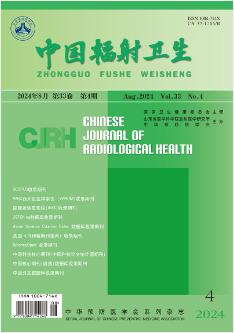非共面场技术在胃癌静态调强放射治疗中的剂量研究
引用次数: 0
摘要
目的比较非共面和共面场技术在癌症静态调强放疗中的剂量特性,为临床放疗方案选择提供参考。方法选择36例癌症患者在黄冈市中心医院接受调强放疗,按A、B方案设计。A组采用7场共平面技术,B组采用7瓣非共平面技术。我们比较了A组和B组在优化监测单元、危险器官剂量测定和靶区剂量测定方面的差异。B组靶区均匀性指数(0.14±0.02)、一致性指数(0.98±0.01)、D min(4 315.21±16.74)cGy、D mean(4 679.28±28.39,B组左、右肾的V2 0和V3 0均低于A组。脊髓的D max(3 408.57±46.03)cGy、D mean(1 250.32±14.27)cGy和V2 0(44.91%±6.67%)及小肠的D max。结论非共面场辐射方案在靶剂量分布和器官保护方面具有更大的优势,可在规划设计过程中得到更大的应用。摘要: 目的 通过比较非共面射野与共面射野计划在胃癌静态调强中的剂量学特点, 为临床放疗计划选择提供依 据。 方法 选取黄冈市中心医院接受调强放射治疗的胃癌患者 36例, 每名患者均设计A、 B 2组计划, A.组采用 7.野 共面技术, B组采用 7.野非共面技术, 比较 A.组和 B组优化后机器跳数、危及器官和靶区的剂量学差异。 结果 A、 B两组计划均能满足医生要求, B组靶区均匀性指数 HI(0.14±0.02)和适形度指数 CI(0.98±0.01),靶区 D最小值(4 315.21±16.74)cGy,D平均值(4 679.28±28.39)cGy和 D最大值(4 952.30±33.26)cGy均优于 A.组, 且 B组机器跳数更 少, 差异有统计学意义 (P<0.05)B组左右侧肾脏 D最大值、D平均值、V 15、V 20和 V 30均低于A.组, 脊髓的 D最大值(3 408.57±46.03)cGy,D平均值(1 250.32±14.27)cGy和 v20(44.91%±6.67%)以及小肠的 D最大值(3 408.57±46.03)cGy、D平均值(1 720.55±17.42)cGy、V 20(25.31%±7.78%)和 V 30 18.52%±1.56%)也均低于 A.组, 差异有统计学意义 (P<0.05)结论 非共面射野计划在靶区剂量分布和危及器官保护上更优, 计划设计过程中可以更多的考虑非共面布野技术。本文章由计算机程序翻译,如有差异,请以英文原文为准。
Dosimetric investigation of non-coplanar field technology in static intensity-modulated radiation therapy for gastric carcinoma
Objective To compare the dosimetric characteristics of non-coplanar and coplanar field technology
in static intensity-modulated radiotherapy of gastric cancer patients, so as to provide
a reference for clinical radiotherapy plan selection.
Methods Thirty-six patients with gastric cancer were selected to receive intensity-modulated
radiotherapy in Huanggang Central Hospital, which was designed plan A and B. Group
A used 7-field coplanar technology, while Group B used 7-fleld non-coplanar technology.
We compared the differences of the optimized monitor unit, the dosimetry of organs
at risk and target areas between group A and group B.
Results Both group A and B could meet the requirements of doctors. The homogeneity index
(0.14 ± 0.02), the conformity index (0.98 ± 0.01), D
min (4 315.21 ± 16.74) cGy, D
mean (4 679.28 ± 28.39) cGy and D
max (4 952.30 ± 33.26) cGy of target areas in group B were better than those of group
A. Moreover, the monitor unit of group B was much lower than that of group A, and
the difference was statistically significant (
P < 0.05). The D
max, D
mean, V
15, V
20 and V
30 of the left and right kidneys in group B were lower than those of group A. The D
max (3 408.57 ± 46.03) cGy, D
mean (1 250.32 ± 14.27) cGy and V
20 (44.91% ± 6.67%) of spinal cord and the D
max (3 408.57 ± 46.03) cGy, D
mean (1 720.55 ± 17.42) cGy, V
20 (25.31% ± 7.78%) and V
30 (18.52% ± 1.56%) of small intestine were also lower than those of group A. The differences
were statistically significant (
P < 0.05).
Conclusion The non-coplanar field radiation plan has more advantages in terms of target dose
distribution and protection of organs so that it can be more considerably used in
the process of planning and design.
摘要: 目的 通过比较非共面射野与共面射野计划在胃癌静态调强中的剂量学特点, 为临床放疗计划选择提供依 据。
方法 选取黄冈市中心医院接受调强放射治疗的胃癌患者 36 例, 每名患者均设计A、B 2 组计划, A 组采用 7 野 共面技术, B 组采用 7 野非共面技术, 比较
A 组和 B 组优化后机器跳数、危及器官和靶区的剂量学差异。
结果 A、B 两组计划均能满足医生要求, B 组靶区均匀性指数 HI (0.14 ± 0.02)和适形度指数 CI (0.98 ± 0.01), 靶区 D
min (4 315.21 ± 16.74) cGy, D
mean (4 679.28 ± 28.39) cGy 和 D
max (4 952.30 ± 33.26) cGy 均优于 A 组, 且 B 组机器跳数更 少, 差异有统计学意义 (
P < 0.05)。B 组左右侧肾脏 D
max、
D
mean、
V
15、
V
20 和 V
30均低于A组, 脊髓的 D
max (3 408.57 ± 46.03) cGy、
D
mean (1 250.32 ± 14.27) cGy 和 V
20 (44.91% ± 6.67%)以及小肠的 D
max (3 408.57 ± 46.03) cGy、
D
mean (1 720.55 ± 17.42) cGy、
V
20 (25.31% ± 7.78%) 和 V
30 18.52% ± 1.56%)也均低于 A 组, 差异有统计学意义 (
P < 0.05)。
结论 非共面射野计划在靶区剂量分布和危及器官保护上更优, 计划设计过程中可以更多的考虑非共面布野技术。
求助全文
通过发布文献求助,成功后即可免费获取论文全文。
去求助
来源期刊
CiteScore
0.80
自引率
0.00%
发文量
7142
期刊介绍:
Chinese Journal of Radiological Health is one of the Source Journals for Chinese Scientific and Technical Papers and Citations and belongs to the series published by Chinese Preventive Medicine Association (CPMA). It is a national academic journal supervised by National Health Commission of the People’s Republic of China and co-sponsored by Institute of Radiation Medicine, Shandong Academy of Medical Sciences and CPMA, and is a professional academic journal publishing research findings and management experience in the field of radiological health, issued to the public in China and abroad. Under the guidance of the Communist Party of China and the national press and publication policies, the Journal actively publicizes the guidelines and policies of the Party and the state on health work, promotes the implementation of relevant laws, regulations and standards, and timely reports new achievements, new information, new methods and new products in the specialty, with the aim of organizing and promoting the academic communication of radiological health in China and improving the academic level of the specialty, and for the purpose of protecting the health of radiation workers and the public while promoting the extensive use of radioisotopes and radiation devices in the national economy. The main columns include Original Articles, Expert Comments, Experience Exchange, Standards and Guidelines, and Review Articles.

 求助内容:
求助内容: 应助结果提醒方式:
应助结果提醒方式:


